英语介词的正确使用方法精编版
- 格式:ppt
- 大小:263.50 KB
- 文档页数:20
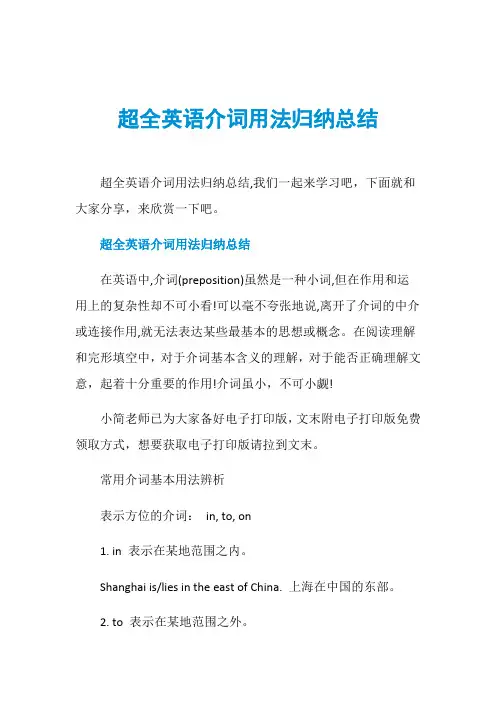
超全英语介词用法归纳总结超全英语介词用法归纳总结,我们一起来学习吧,下面就和大家分享,来欣赏一下吧。
超全英语介词用法归纳总结在英语中,介词(preposition)虽然是一种小词,但在作用和运用上的复杂性却不可小看!可以毫不夸张地说,离开了介词的中介或连接作用,就无法表达某些最基本的思想或概念。
在阅读理解和完形填空中,对于介词基本含义的理解,对于能否正确理解文意,起着十分重要的作用!介词虽小,不可小觑!小简老师已为大家备好电子打印版,文末附电子打印版免费领取方式,想要获取电子打印版请拉到文末。
常用介词基本用法辨析表示方位的介词:in, to, on1. in 表示在某地范围之内。
Shanghai is/lies in the east of China. 上海在中国的东部。
2. to 表示在某地范围之外。
Japan is/lies to the east of China. 日本位于中国的东面。
3. on 表示与某地相邻或接壤。
Mongolia is/lies on the north of China. 蒙古国位于中国北边表示计量的介词:at, for, by1. at 表示“以……速度”“以……价格”。
It flies at about 900 kilometers an hour. 它以每小时900公里的速度飞行。
I sold my car at a high price. 我以高价出售了我的汽车。
2. for 表示“用……交换,以……为代价”。
He sold his car for 500 dollars. 他以五百元把车卖了。
注意:at表示单价(price) ,for表示总钱数。
3. by 表示“以……计”,后跟度量单位。
They paid him by the month. 他们按月给他计酬。
Here eggs are sold by weight. 在这里鸡蛋是按重量卖的。
表示材料的介词:of, from, in1. of 成品仍可看出原料。
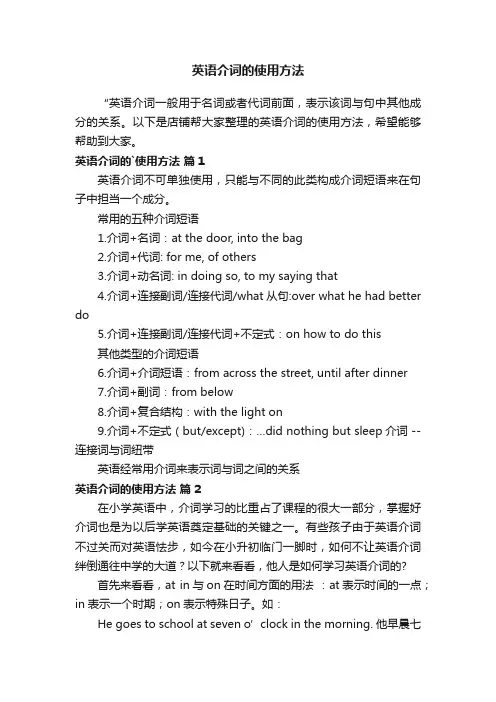
英语介词的使用方法“英语介词一般用于名词或者代词前面,表示该词与句中其他成分的关系。
以下是店铺帮大家整理的英语介词的使用方法,希望能够帮助到大家。
英语介词的`使用方法篇1英语介词不可单独使用,只能与不同的此类构成介词短语来在句子中担当一个成分。
常用的五种介词短语1.介词+名词:at the door, into the bag2.介词+代词: for me, of others3.介词+动名词: in doing so, to my saying that4.介词+连接副词/连接代词/what从句:over what he had better do5.介词+连接副词/连接代词+不定式:on how to do this其他类型的介词短语6.介词+介词短语:from across the street, until after dinner7.介词+副词:from below8.介词+复合结构:with the light on9.介词+不定式(but/except):…did nothing but sleep介词 -- 连接词与词纽带英语经常用介词来表示词与词之间的关系英语介词的使用方法篇2在小学英语中,介词学习的比重占了课程的很大一部分,掌握好介词也是为以后学英语奠定基础的关键之一。
有些孩子由于英语介词不过关而对英语怯步,如今在小升初临门一脚时,如何不让英语介词绊倒通往中学的大道?以下就来看看,他人是如何学习英语介词的?首先来看看,at in与on在时间方面的用法:at表示时间的一点;in表示一个时期;on表示特殊日子。
如:He goes to school at seven o’clock in the morning. 他早晨七点上学。
Can you finish the work in two days? 你能在两天内完成这个工作吗?Linda was born on the second of May. 琳达五月二日出生。
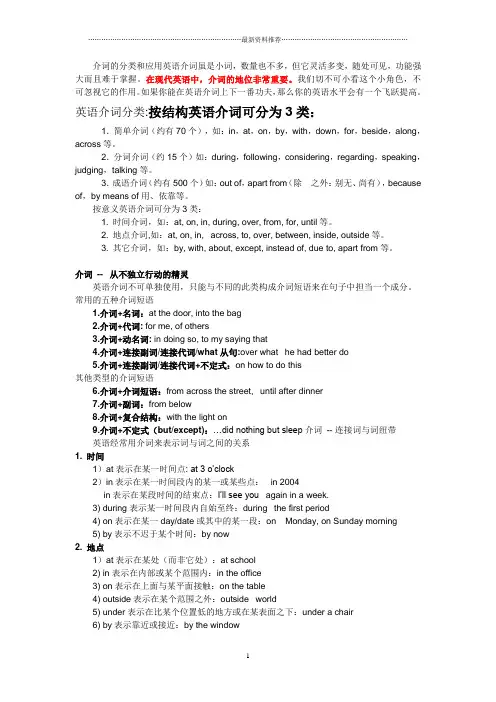
介词的分类和应用英语介词虽是小词,数量也不多,但它灵活多变,随处可见,功能强大而且难于掌握。
在现代英语中,介词的地位非常重要。
我们切不可小看这个小角色,不可忽视它的作用。
如果你能在英语介词上下一番功夫,那么你的英语水平会有一个飞跃提高。
英语介词分类:按结构英语介词可分为3类:1.简单介词(约有70个),如:in,at,on,by,with,down,for,beside,along,across等。
2.分词介词(约15个)如:during,following,considering,regarding,speaking,judging,talking等。
3.成语介词(约有500个)如:out of,apart from(除之外:别无、尚有),because of,by means of用、依靠等。
按意义英语介词可分为3类:1. 时间介词,如:at, on, in, during, over, from, for, until等。
2. 地点介词,如:at, on, in, across, to, over, between, inside, outside等。
3. 其它介词,如:by, with, about, except, instead of, due to, apart from等。
介词-- 从不独立行动的精灵英语介词不可单独使用,只能与不同的此类构成介词短语来在句子中担当一个成分。
常用的五种介词短语1.介词+名词:at the door, into the bag2.介词+代词: for me, of others3.介词+动名词: in doing so, to my saying that4.介词+连接副词/连接代词/what从句:over what he had better do5.介词+连接副词/连接代词+不定式:on how to do this其他类型的介词短语6.介词+介词短语:from across the street, until after dinner7.介词+副词:from below8.介词+复合结构:with the light on9.介词+不定式(but/except):…did nothing but sleep介词-- 连接词与词纽带英语经常用介词来表示词与词之间的关系1. 时间1)at表示在某一时间点: at 3 o’clock2)in表示在某一时间段内的某一或某些点:in 2004in表示在某段时间的结束点:I’ll see you again in a week.3) during表示某一时间段内自始至终:during the first period4) on表示在某一day/date或其中的某一段:on Monday, on Sunday morning5) by表示不迟于某个时间:by now2. 地点1)at表示在某处(而非它处):at school2) in表示在内部或某个范围内:in the office3) on表示在上面与某平面接触:on the table4) outside表示在某个范围之外:outside world5) under表示在比某个位置低的地方或在某表面之下:under a chair6) by表示靠近或接近:by the window3. 原因1)because of表示因为或以…为理由:because of my father2) for表示动作或活动的目的、目标或意图:for sale3) out of表示起源、来源或原因:out of duty4. 方式1)with表示以…方式:with skill2)in表示以某种方式:in French, in cash,in this way5. 方法1) by表示方法、手段: by the back road, by bus, by working hard2) on表示运送方式:on a train, on foot3) in表示途径或材料:in oils1. 介词短语的词性--形容词1) 常用于做定语的介词短语的介词of: a child of sixwith: a man with a suitcasein: a girl in redto: the key to the doorfor: a war for moneyabout: an agreement about trade2)常用于做表语的介词短语的介词at: She was at a loss.beyond;The road is beyond the hill.in: He’s still in danger.of: It’s of no value.on: He is on guard.out of: I’m out of job.under: He’s under forty.3) 用于做宾语补足语:I saw George at work.A cold kept him in bed for 7 days.2. 介词短语的词性—副词1)做状语,主要用于修饰谓语:He has been here since Monday.Bake it is for two hours.2) 用于be+adj.结构:She is afraid of snakes.I’m sorry about that.3) 修饰非谓语动词:I asked to speak to the headmaster.介词--短语动词中的关键角色含有介词的短语动词1. v.+ prep :agree with/to/on/in, answer for, ask for, come across, go after, live on, run into, head for, look for/after/at 等。
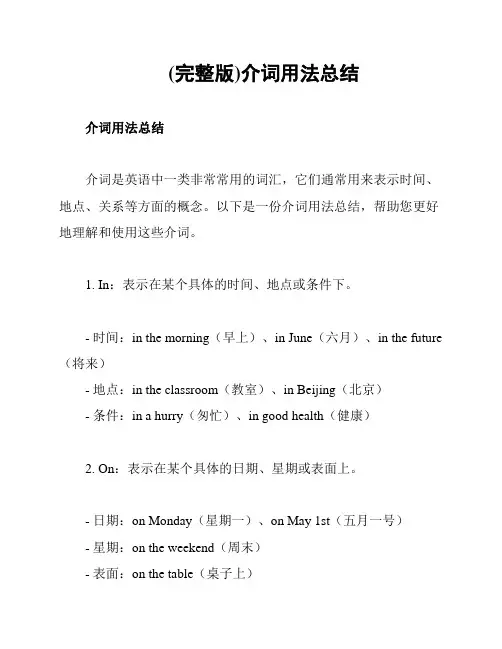
(完整版)介词用法总结介词用法总结介词是英语中一类非常常用的词汇,它们通常用来表示时间、地点、关系等方面的概念。
以下是一份介词用法总结,帮助您更好地理解和使用这些介词。
1. In:表示在某个具体的时间、地点或条件下。
- 时间:in the morning(早上)、in June(六月)、in the future (将来)- 地点:in the classroom(教室)、in Beijing(北京)- 条件:in a hurry(匆忙)、in good health(健康)2. On:表示在某个具体的日期、星期或表面上。
- 日期:on Monday(星期一)、on May 1st(五月一号)- 星期:on the weekend(周末)- 表面:on the table(桌子上)3. At:表示在某个具体的时间、地点或时刻。
- 时间:at 3 o'clock(三点钟)、at night(晚上)- 地点:at the park(公园)- 时刻:at the moment(此刻)4. By:表示通过某种方式或由某人完成某事。
- 方式:go to work by car(坐车上班)- 人:the book written by Mark Twain(马克·吐温所写的书)5. With:表示陪同、具备、使用等概念。
- 陪同:go shopping with friends(和朋友一起去购物)- 具备:a house with a garden(带有花园的房子)- 使用:write with a pen(用钢笔写)6. For:表示为了某个目的、期间或持续时间。
- 目的:study for the test(为考试研究)- 期间:wait for a while(等一会儿)- 持续时间:sleep for eight hours(睡八个小时)以上是介词的基本用法总结,希望对您有所帮助!。
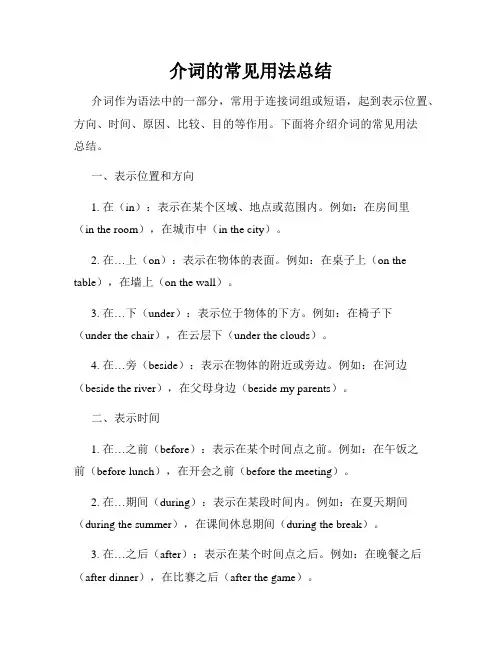
介词的常见用法总结介词作为语法中的一部分,常用于连接词组或短语,起到表示位置、方向、时间、原因、比较、目的等作用。
下面将介绍介词的常见用法总结。
一、表示位置和方向1. 在(in):表示在某个区域、地点或范围内。
例如:在房间里(in the room),在城市中(in the city)。
2. 在…上(on):表示在物体的表面。
例如:在桌子上(on the table),在墙上(on the wall)。
3. 在…下(under):表示位于物体的下方。
例如:在椅子下(under the chair),在云层下(under the clouds)。
4. 在…旁(beside):表示在物体的附近或旁边。
例如:在河边(beside the river),在父母身边(beside my parents)。
二、表示时间1. 在…之前(before):表示在某个时间点之前。
例如:在午饭之前(before lunch),在开会之前(before the meeting)。
2. 在…期间(during):表示在某段时间内。
例如:在夏天期间(during the summer),在课间休息期间(during the break)。
3. 在…之后(after):表示在某个时间点之后。
例如:在晚餐之后(after dinner),在比赛之后(after the game)。
三、表示原因1. 因为(because of):表示由于某个原因。
例如:因为天气原因(because of the weather),因为健康问题(because of health issues)。
2. 由于(due to):表示由于某种情况或原因。
例如:由于交通堵塞(due to traffic congestion),由于工作原因(due to work commitments)。
四、表示比较1. 像…一样(like):表示两个或多个事物在某些方面的相似性。

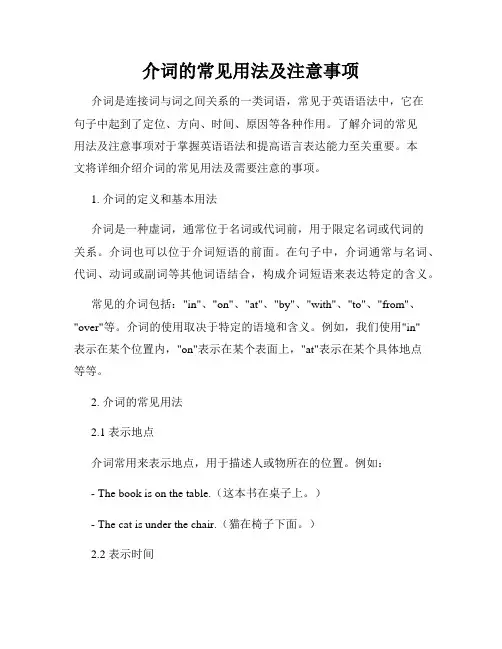
介词的常见用法及注意事项介词是连接词与词之间关系的一类词语,常见于英语语法中,它在句子中起到了定位、方向、时间、原因等各种作用。
了解介词的常见用法及注意事项对于掌握英语语法和提高语言表达能力至关重要。
本文将详细介绍介词的常见用法及需要注意的事项。
1. 介词的定义和基本用法介词是一种虚词,通常位于名词或代词前,用于限定名词或代词的关系。
介词也可以位于介词短语的前面。
在句子中,介词通常与名词、代词、动词或副词等其他词语结合,构成介词短语来表达特定的含义。
常见的介词包括:"in"、"on"、"at"、"by"、"with"、"to"、"from"、"over"等。
介词的使用取决于特定的语境和含义。
例如,我们使用"in"表示在某个位置内,"on"表示在某个表面上,"at"表示在某个具体地点等等。
2. 介词的常见用法2.1 表示地点介词常用来表示地点,用于描述人或物所在的位置。
例如:- The book is on the table.(这本书在桌子上。
)- The cat is under the chair.(猫在椅子下面。
)2.2 表示时间介词还常用来表示时间,用于描述事件发生的时间。
例如:- I will meet her at 8 o'clock.(我将在8点钟见她。
)- They usually have dinner on Sundays.(他们通常在星期天吃晚饭。
)2.3 表示方式或原因有些介词可以表示某个动作的方式或原因。
例如:- He broke the vase with a hammer.(他用锤子打碎了花瓶。
)- She cried because of the sad news.(她因为这个悲伤的消息而哭了。
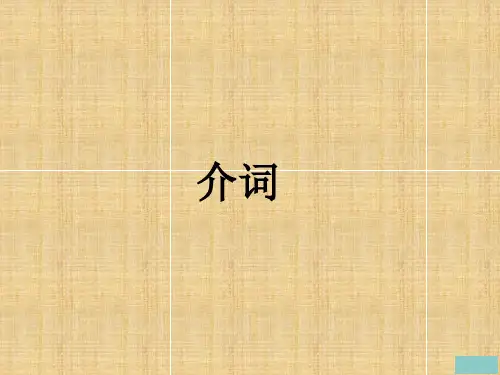
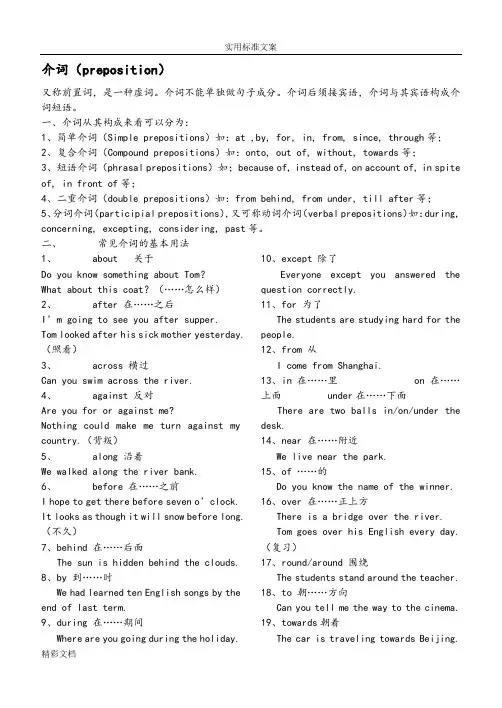
介词(preposition)又称前置词,是一种虚词。
介词不能单独做句子成分。
介词后须接宾语,介词与其宾语构成介词短语。
一、介词从其构成来看可以分为:1、简单介词(Simple prepositions)如:at ,by, for, in, from, since, through等;2、复合介词(Compound prepositions)如:onto, out of, without, towards等;3、短语介词(phrasal prepositions)如;because of, instead of, on account of, in spite of, in front of等;4、二重介词(double prepositions)如:from behind, from under, till after等;5、分词介词(participial prepositions),又可称动词介词(verbal prepositions)如:during, concerning, excepting, considering, past等。
二、常见介词的基本用法1、 about 关于Do you know something about Tom?What about this coat?(……怎么样)2、 after 在……之后I’m going to see you after supper. Tom looked after his sick mother yesterday.(照看)3、 across 横过Can you swim across the river.4、 against 反对Are you for or against me?Nothing could make me turn against my country.(背叛)5、 along 沿着We walked along the river bank.6、 before 在……之前I hope to get there before seven o’clock. It looks as though it will snow before long.(不久)7、behind 在……后面The sun is hidden behind the clouds.8、by 到……时We had learned ten English songs by the end of last term.9、during 在……期间Where are you going during the holiday. 10、except 除了Everyone except you answered the question correctly.11、for 为了The students are studying hard for the people.12、from 从I come from Shanghai.13、in 在……里 on 在……上面 under在……下面There are two balls in/on/under the desk.14、near 在……附近We live near the park.15、of ……的Do you know the name of the winner.16、over 在……正上方There is a bridge over the river.Tom goes over his English every day.(复习)17、round/around 围绕The students stand around the teacher.18、to 朝……方向Can you tell me the way to the cinema.19、towards朝着The car is traveling towards Beijing.20、with 和……一起me?Would you like to go to the cinema with学习这些介词时可以先记住它的汉语意思,然后参照例句来加深理解,并在今后的学习中加以灵活运用。
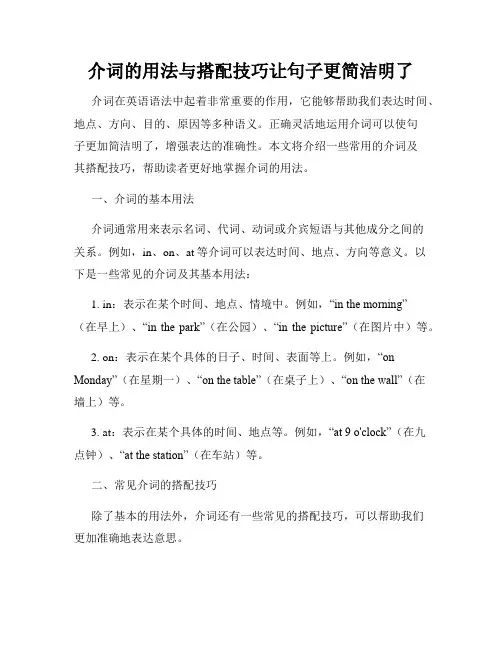
介词的用法与搭配技巧让句子更简洁明了介词在英语语法中起着非常重要的作用,它能够帮助我们表达时间、地点、方向、目的、原因等多种语义。
正确灵活地运用介词可以使句子更加简洁明了,增强表达的准确性。
本文将介绍一些常用的介词及其搭配技巧,帮助读者更好地掌握介词的用法。
一、介词的基本用法介词通常用来表示名词、代词、动词或介宾短语与其他成分之间的关系。
例如,in、on、at等介词可以表达时间、地点、方向等意义。
以下是一些常见的介词及其基本用法:1. in:表示在某个时间、地点、情境中。
例如,“in the morning”(在早上)、“in the park”(在公园)、“in the picture”(在图片中)等。
2. on:表示在某个具体的日子、时间、表面等上。
例如,“on Monday”(在星期一)、“on the table”(在桌子上)、“on the wall”(在墙上)等。
3. at:表示在某个具体的时间、地点等。
例如,“at 9 o'clock”(在九点钟)、“at the station”(在车站)等。
二、常见介词的搭配技巧除了基本的用法外,介词还有一些常见的搭配技巧,可以帮助我们更加准确地表达意思。
1. 表示位置关系:介词常用来表示物体或人在空间中的位置关系。
例如,“in front of”(在...前面)、“behind”(在...后面)、“next to”(在...旁边)、“above”(在...上面)、“under”(在...下面)等。
2. 表示原因与结果:介词也可以用来表示原因与结果的关系。
例如,“because of”(因为)、“due to”(由于)、“result from”(由...引起)等。
3. 表示方式与手段:介词可以表示某种方式或手段。
例如,“by”(通过)、“with”(用)等。
例如,“by email”(通过电子邮件)、“with a knife”(用刀)等。
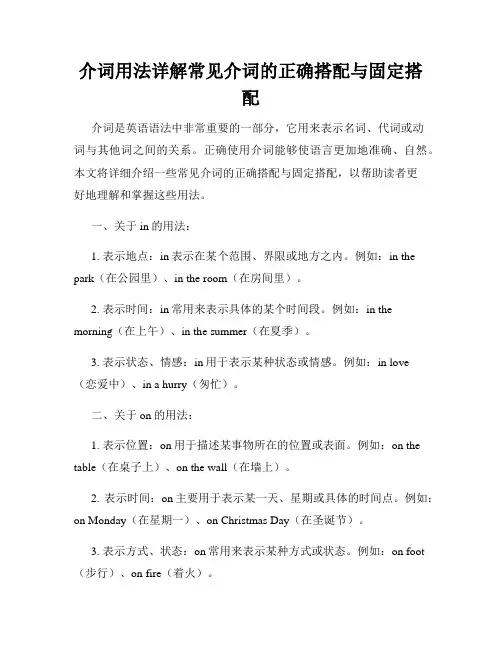
介词用法详解常见介词的正确搭配与固定搭配介词是英语语法中非常重要的一部分,它用来表示名词、代词或动词与其他词之间的关系。
正确使用介词能够使语言更加地准确、自然。
本文将详细介绍一些常见介词的正确搭配与固定搭配,以帮助读者更好地理解和掌握这些用法。
一、关于in的用法:1. 表示地点:in表示在某个范围、界限或地方之内。
例如:in the park(在公园里)、in the room(在房间里)。
2. 表示时间:in常用来表示具体的某个时间段。
例如:in the morning(在上午)、in the summer(在夏季)。
3. 表示状态、情感:in用于表示某种状态或情感。
例如:in love(恋爱中)、in a hurry(匆忙)。
二、关于on的用法:1. 表示位置:on用于描述某事物所在的位置或表面。
例如:on the table(在桌子上)、on the wall(在墙上)。
2. 表示时间:on主要用于表示某一天、星期或具体的时间点。
例如:on Monday(在星期一)、on Christmas Day(在圣诞节)。
3. 表示方式、状态:on常用来表示某种方式或状态。
例如:on foot (步行)、on fire(着火)。
三、关于at的用法:1. 表示地点:at用于表示具体的某个地点或位置。
例如:at the airport(在机场)、at the bus stop(在公交车站)。
2. 表示时间:at用于表示具体的某一时刻。
例如:at 8 o'clock(在8点钟)、at midnight(在午夜)。
3. 表示某种状态、情感:at常用来表示某种状态或情感。
例如:at peace(和平)、at a loss(困惑)。
四、关于to的用法:1. 表示方向、目的地:to用于表示某个方向或目的地。
例如:go to school(去学校)、fly to Beijing(飞往北京)。
2. 表示时间:to用于表示某个时间点或一段时间之后。
英语词组介词使用规律词组介词使用规律一:in + 地点(表示在……里面)中文翻译:在……里面英语解释:When we use “in” with a place, it shows that something is within the boundaries of that place. For example, if we say a book is in the box, it means the book is located inside the box.运用情况:当我们想要描述一个物体处于某个封闭空间内部的时候就可以用这个词组。
就像我们在找东西的时候,想表达某个东西在某个容器或者空间内部,这时候“in”就派上用场啦。
例子:My keys are in my pocket.词组介词使用规律二:on + 表面(表示在……上面)中文翻译:在……上面英语解释:“On” is used when one thing is touching the surface of another. Say there's a cup on the table, it means the cup is resting directly above the surface of the table.运用情况:要是一个东西直接接触并位于另一个东西的表面,就可以用“on”这个介词。
这就好比你看到一只猫趴在汽车的引擎盖上,你就可以说The cat is on the car's hood.例子:The book is on the desk.词组介词使用规律三:at + 小地点(表示在……)中文翻译:在……(小地点)英语解释:“At” is used for specif ic small places. For instance, when we say “I am at the bus stop”, it means I am present at that particular small location which is the bus stop.运用情况:当提到比较小的、具体的地点,像车站、商店门口之类的小地方时,“at”就很合适。
介词短语的正确位置和用法详解介词短语是由介词与其宾语(名词、代词、动名词等)组成的短语结构。
在英语中,介词短语的正确位置和用法常常成为初学者的困扰之处。
本文将详细介绍介词短语的正确位置和用法,以帮助读者更好地理解和运用。
一、介词短语的位置1. 放在动词后面一般情况下,介词短语放置在动词之后,修饰该动词的宾语。
例如:- She is talking about her new job.(她正在谈论她的新工作。
)- He is looking for his keys.(他正在找他的钥匙。
)2. 放在名词后面介词短语也可以放在名词之后,修饰该名词。
例如:- The book on the table is mine.(桌子上的书是我的。
)- She bought a dress with a floral pattern.(她买了一件有花纹的连衣裙。
)3. 放在句首有些情况下,介词短语可以放在句首,起到引导状语从句的作用。
例如:- In order to pass the exam, he studied hard.(为了通过考试,他努力学习。
)- With a smile on his face, he greeted his friends.(脸上带着微笑,他向朋友们打招呼。
)二、常见的介词用法1. In(在):- 表示位置:in the park(在公园里)- 表示时间:in the morning(在早上)- 表示方式:in a hurry(匆忙地)2. On(在、在上面):- 表示位置:on the table(在桌子上)- 表示时间:on Monday(在周一)- 表示状态:on fire(起火)3. At(在):- 表示位置:at the bus station(在公交车站)- 表示时间:at 8 o'clock(在8点)- 表示活动:at a party(参加派对)4. To(到):- 表示方向:go to school(去学校)- 表示目的:a present for you(给你的礼物)- 表示比较:superior to(优于)5. from(从):- 表示出发点:come from China(来自中国)- 表示来源:a letter from my mother(我妈妈写的一封信)- 表示距离:far from here(离这里很远)6. with(和):- 表示伴随:go shopping with friends(和朋友一起去购物)- 表示工具:write with a pen(用钢笔写字)- 表示原因:cry with joy(由于喜悦而哭泣)三、常见错误使用介词短语的例子1.错误:She is waiting the bus.正确:She is waiting for the bus.2.错误:I will see you in next week.正确:I will see you next week.3. 错误:He was absent from the meeting.正确:He was absent at the meeting.四、小结介词短语在句子中起到修饰名词、动词、状语从句等作用,用法灵活多样。
英语介词用法最全总结英语介词是学习英语语法中非常重要的一部分,它们在句子中起着连接词的作用,指示名词、代词或动词与其他词之间的关系。
正确地使用介词可以使句子更加生动、准确,并且对于掌握英语的表达能力至关重要。
下面将为大家总结英语中常见的介词用法。
1. 位置(Location)介词在描述位置时非常常用。
例如,在描述位置关系时可以使用"in"、"on"、"under"、"beside"、"in front of" 等。
比如:The book is on the table(书在桌子上)。
2. 时间(Time)表达时间关系时,介词也是必不可少的。
例如,在描述时间时可以使用 "at"、"in"、"on"、"during"、"for" 等。
比如:I will meet you at 7 o'clock(我会在7点见你)。
3. 方式(Manner)介词在描述方式时的使用较为灵活。
比如:She walked with confidence(她自信地走着)。
4. 原因(Cause)介词可以用于表达原因。
比如:They canceled the trip due to bad weather(由于天气恶劣,他们取消了旅行)。
5. 目的(Purpose)介词也能表达目的。
比如:He went to the store to buy some groceries (他去商店买些食品)。
6. 所属关系(Possession)介词可以用于表达所属关系。
比如:This book belongs to me(这本书是我的)。
7. 比较(Comparison)在进行比较时,介词也可以派上用场。
比如:I am taller than my sister(我比我妹妹高)。
介词用法详解常见介词的正确使用介词是一类在句子中用来连接名词、代词、动词或其他词汇的虚词。
在英语中,常见的介词有多个,如in、on、at、to等。
正确运用介词有助于表达清晰准确的意思,本文将详细介绍常见介词的正确使用。
一、介词in的用法1. 表示地点:in表示某个范围内的具体地点。
例如:- He is in the park.(他在公园里。
)- The book is in the bag.(书在包里。
)2. 表示时间:in表示较长的时间段。
例如:- I will visit my parents in the summer.(我将在夏天看望我的父母。
)- The meeting will start in an hour.(会议将在一个小时后开始。
)3. 表示状态或情况:in表示某种状态或情况。
例如:- She is in good health.(她身体很健康。
)- The company is in financial trouble.(公司处于财务困境中。
)二、介词on的用法1. 表示底下、附着或接触:on表示物体在另一个物体的表面上。
例如:- There is a cup on the table.(桌子上有一个杯子。
)- The picture is hanging on the wall.(那幅画挂在墙上。
)2. 表示时间:on表示具体的某一天、日期或星期。
例如:- The party is on Friday.(聚会在星期五。
)- My birthday is on July 15th.(我的生日是在7月15日。
)3. 表示关于、涉及或致力于:on表示与某事相关。
例如:- He is an expert on economics.(他是一个经济学专家。
)- She is working on a new project.(她正在进行一个新项目。
)三、介词at的用法1. 表示地点:at表示某个具体的地点。
介词的正确用法介词是连接词与词、短语与短语、句子与句子之间关系的词类。
在英语中,介词的正确使用对于准确表达意思至关重要。
本文将介绍介词的基本用法,并提供一些例子帮助读者更好地理解如何正确使用介词。
1. 表示位置关系介词在表示位置关系时非常常见。
以下是一些常用的表达方式:- in:表示在某个大的范围之内,如 in the park(在公园里),in the city(在城市里)。
- on:表示在某个表面上,如 on the table(在桌子上),on the wall (在墙上)。
- at:表示在某个具体的地方,如 at home(在家里),at the office (在办公室)。
2. 表示时间关系介词在表示时间关系时也很常见。
以下是一些常用的表达方式:- at:表示在具体的时间点上,如 at 7 o'clock(在7点钟),at noon (在中午)。
- on:表示在某个具体的日期或日子上,如on Monday(星期一),on New Year's Day(元旦)。
- in:表示在一个时间段内,如 in the morning(早上),in December(在12月)。
3. 表示原因和目的介词也可以用来表示原因和目的。
以下是一些常见的表达方式:- for:表示做某事的目的,如 for studying(为了学习)。
- because of:表示某个原因,如 because of the rain(因为下雨)。
4. 表示方式和手段介词还可以用来表示方式和手段。
以下是一些常用的表达方式:- by:表示通过某种方式或手段,如 by car(乘坐汽车),by email (通过电子邮件)。
5. 表示所有关系介词还可以用来表示所有关系。
以下是一些常见的表达方式:- of:表示所属关系,如 the book of John(约翰的书)。
- 's:表示所属关系,如 John's book(约翰的书)。
(详细版)介词的用法总结详细版:介词的用法总结介词是连接名词、代词、动词等成分的虚词,常用来表示时间、地点、方式、原因等关系。
在写作中,使用介词可以使句子更加连贯,表达得更加准确。
以下是介词的一些常用用法总结:表示时间关系1. at:表示准确的时间点,例如 at 6 pm,在某一天的某个时间点。
2. on:表示具体的某一天或日期,例如on Monday,在某一天。
3. in:表示一段时间内,在某一年、月份、时间段等。
例如 in May,在五月。
4. since:表示从某个时间开始一直到现在,例如 since last year,从去年开始到现在。
5. for:表示持续的时间,在某段时间内。
例如 for two hours,持续两个小时。
表示地点关系1. at:表示在某个位置。
例如 at home,在家。
2. on:表示在一个平面面上。
例如 on the table,在桌子上。
3. in:表示在一个封闭的空间内。
例如in the room,在房间里。
4. to:表示到某个地方。
例如 go to school,去学校。
表示方式、原因、目的等关系1. by:表示通过某种方式。
例如 by plane,乘飞机。
2. with:表示用某种工具或伴随某人物。
例如 write with pen,用笔写。
3. for:表示为了某种目的。
例如 for health,为了健康。
4. because of:表示因为某种原因。
例如 because of the rain,因为下雨。
以上只是介词用法的一部分,需要灵活运用,不要生搬硬套,以免出现错误。
希望以上总结对您有所帮助。